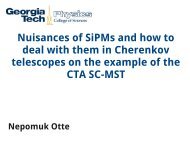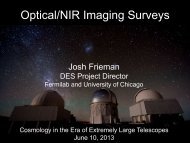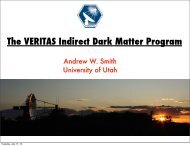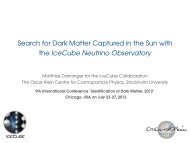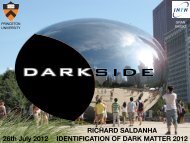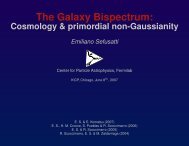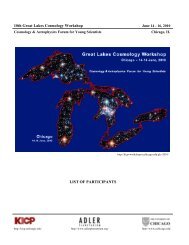Characterization of SiPMs for Use in Cherenkov ... - KICP Workshops
Characterization of SiPMs for Use in Cherenkov ... - KICP Workshops
Characterization of SiPMs for Use in Cherenkov ... - KICP Workshops
You also want an ePaper? Increase the reach of your titles
YUMPU automatically turns print PDFs into web optimized ePapers that Google loves.
David A. Williams<br />
daw@ucsc.edu<br />
Santa Cruz Institute <strong>for</strong><br />
Particle Physics<br />
University <strong>of</strong> Cali<strong>for</strong>nia<br />
Santa Cruz<br />
May 10, 2013<br />
<strong>Characterization</strong> <strong>of</strong> <strong>SiPMs</strong> <strong>for</strong><br />
<strong>Use</strong> <strong>in</strong> <strong>Cherenkov</strong> Telescopes<br />
In collaboration with: Aurelien Bouvier, Lloyd Gebremedh<strong>in</strong>, Naoya Hidaka, Jim H<strong>in</strong>ton, Caitl<strong>in</strong><br />
Johnson, Andrey Kuznetsov, Akira Okumura, Nepomuk Otte, Hiro Tajima, Richard White
Camera <strong>for</strong> Schwarzschild-Couder<br />
Telescope<br />
Telescope design aimed at wide FoV, high angular<br />
resolution with good <strong>of</strong>f-axis response.<br />
Demagnify<strong>in</strong>g 2-mirror design reduces plate scale<br />
allow<strong>in</strong>g MAPMTs/<strong>SiPMs</strong> and reduc<strong>in</strong>g costs<br />
below $70 per pixel allow<strong>in</strong>g much higher<br />
resolution camera at same cost.<br />
ASIC electronics with a high level <strong>of</strong> <strong>in</strong>tegration<br />
(TARGET) <strong>for</strong> cost and power reduction.<br />
Deep memory <strong>for</strong> trigger flexibility – e.g., higher<br />
multiplicity triggers <strong>for</strong> close spac<strong>in</strong>g, dynamically<br />
reprogrammable data w<strong>in</strong>dow after trigger,<br />
improved hadronic rejection by <strong>in</strong>clud<strong>in</strong>g nontrigger<strong>in</strong>g<br />
telescopes.<br />
Modular design aimed at low cost, high reliability, and<br />
ease <strong>of</strong> serviceability.<br />
2!
γ-ray Shower<br />
Energy: 1 TeV<br />
Impact Distance: 100m<br />
SC<br />
DC<br />
Proton Shower<br />
Energy: 3.16 TeV<br />
Impact Distance: 0m<br />
3!
Front-End Electronics<br />
Target ASIC<br />
FPGA<br />
HV supply<br />
H10966 MAPMT<br />
(see J. Vandenbroucke’s talk)<br />
5!
Multianode PMT<br />
Hamamatsu<br />
H8500-10x MOD8 = H10966B-10x<br />
Familiarity <strong>of</strong> a PMT<br />
Adequate per<strong>for</strong>mance <strong>in</strong> most respects<br />
Disappo<strong>in</strong>t<strong>in</strong>g PDE, but perhaps not as<br />
bad as we first thought<br />
Straight<strong>for</strong>ward operation — except <strong>for</strong><br />
channel suppression <strong>for</strong> stars<br />
2” segment less than ideal <strong>for</strong> camera<br />
optics<br />
A safe fallback option 6!
SiPM<br />
Much less experience with SiPM<br />
Fussier to operate stably<br />
Star suppression not necessary*<br />
Easily adaptable to camera optics<br />
Several potential vendors<br />
Three ma<strong>in</strong> concerns:<br />
1) Long pulse shape<br />
2) Optical crosstalk – equivalent to PMT afterpuls<strong>in</strong>g<br />
3) Photon detection efficiency – too poor <strong>in</strong> blue; too good<br />
<strong>in</strong> red<br />
4) Suitable pack<strong>in</strong>g to m<strong>in</strong>imize dead area<br />
7!
SiPM devices tested & expected<br />
Hamamatsu<br />
– S11882-3344M (50 µm), S10943-1071 (100 µm), S12545-3344 (100 µm)<br />
– We heard yesterday about com<strong>in</strong>g developments<br />
Excelitas<br />
SensL<br />
– C30742CERH-100-5-1, s/n D4941, D4985 (100 µm)<br />
– Lower crosstalk and higher UV sensitivity devices received recently<br />
– P2MicroSB-30035-X13 (35 µm)<br />
– Higher UV sensitivity devices expected soon<br />
KETEK<br />
– PM3350 (50 µm)<br />
FBK<br />
– 3x3 mm2 (50 µm)<br />
– 4x4 mm2 (50 µm)<br />
8!
MAPMT PDE<br />
Specs <strong>for</strong> SBA QE is 32% m<strong>in</strong> at peak (~35% average advertised by Hamamatsu). UCSC PDE<br />
measurements at 375 nm is ~23.5% on average => ~70% collection efficiency<br />
Hamamatsu 1” SBA PMTs purchased <strong>for</strong> the VERITAS upgrade achieve the advertised QE<br />
Highest PDE values <strong>in</strong> central pixels <strong>of</strong> the tube<br />
9!
normalized signal >0.7PE<br />
MAPMT Dead Space<br />
Tube edges: ~11% dead area; Inner pixel boundaries ~4% loss<br />
10!
MAPMT Crosstalk I<br />
❖ Crosstalk <strong>in</strong> center <strong>of</strong> the pixel ~ 1% (less than<br />
optical cross-talk) but strongly non-uni<strong>for</strong>m<br />
Y (mm)<br />
Y (mm)<br />
X (mm)<br />
X (mm)<br />
10 -1<br />
10 -2<br />
10 -3<br />
10 -1<br />
10 -2<br />
10 -3<br />
Y (mm)<br />
Cross-talk probability<br />
X (mm)<br />
10 -1<br />
10 -2<br />
10 -3<br />
pixel read out<br />
X (mm)<br />
Optical crosstalk measurement <strong>in</strong> the center pixel when fiber<br />
is positioned where crosstalk values are plotted<br />
10 -1<br />
10 -2<br />
10 -3<br />
❖ Crosstalk <strong>in</strong>troduces higher uncerta<strong>in</strong>ty<br />
<strong>in</strong> photon impact po<strong>in</strong>t <strong>in</strong> the focal plane.<br />
❖ ~15% <strong>in</strong>crease <strong>in</strong> the mean uncerta<strong>in</strong>ty<br />
(2.3mm => 2.7mm; 1.5’ => 1.8’)<br />
Uncerta<strong>in</strong>ty simply<br />
orig<strong>in</strong>at<strong>in</strong>g from<br />
f<strong>in</strong>ite pixel size<br />
Crosstalk<br />
11!
MAPMT Crosstalk II<br />
“sympathetic” signal observed <strong>in</strong> all pixels<br />
with amplitude ~0.5% <strong>of</strong> the large signal<br />
illum<strong>in</strong>ated pixel<br />
cross-talk signal<br />
12!
Response vs Incidence Angle<br />
Critical <strong>in</strong> SCT Design:<br />
– All light enters camera <strong>of</strong>f axis<br />
– ~20% fall <strong>of</strong>f near limit<br />
– Net loss <strong>of</strong> ~5% w.r.t. normal <strong>in</strong>cidence<br />
Po<strong>in</strong>ts: Relative measurement us<strong>in</strong>g<br />
small spot illum<strong>in</strong>at<strong>in</strong>g the center <strong>of</strong><br />
one pixel<br />
Red: Unpolarized reflection losses<br />
Blue/Green: Polarlized reflection<br />
losses<br />
Blue: Incidence angle distribution on surface <strong>of</strong><br />
MAPMT (us<strong>in</strong>g A. Okumura’s ROBAST ray<br />
trac<strong>in</strong>g code)<br />
Green: convoluted with measured response at<br />
left<br />
13!
S<strong>in</strong>gle pe response & afterpuls<strong>in</strong>g<br />
1 p.e. peak can be difficult to resolve and very broad. Issue <strong>for</strong> ga<strong>in</strong> calibration?<br />
Low afterpuls<strong>in</strong>g (~0.02%) but >5 p.e. noise will mostly come from tail <strong>of</strong> 1 p.e. distribution<br />
S<strong>in</strong>gle p.e. amplitude distribution tightens with <strong>in</strong>creased HV. Need to compromise with<br />
issues occurr<strong>in</strong>g at high ga<strong>in</strong> operation (see later slide)<br />
Impact on trigger/analysis?<br />
5 p.e.<br />
afterpuls<strong>in</strong>g<br />
14!
MAPMT (H10966B): Ag<strong>in</strong>g<br />
no clear sign <strong>of</strong> ag<strong>in</strong>g up to 70 Coulombs<br />
NSB ok s<strong>in</strong>ce expected charge from NSB: ~2 Coulombs/season<br />
Stars an issue at which brightness?<br />
0<br />
P44 [not aged]<br />
P18 [not aged]<br />
P15 [aged]<br />
70<br />
15!<br />
P15
SiPM Pulse Shap<strong>in</strong>g<br />
NSB rates 20–40 MHz; ~25–50 ns separation between pulses<br />
Excelitas: ~10 ns<br />
Hamamatsu (and most others): ~100-150 ns but fast rise allows<br />
differentiation to get a fast output pulse: ~8 ns (at cost <strong>in</strong> ga<strong>in</strong>)<br />
‘raw’ MPPC pulse<br />
~120ns<br />
MPPC + differentiator<br />
(note: us<strong>in</strong>g 150MHz scope bandwidth)<br />
~8ns<br />
16!
IV behavior – Hamamatsu<br />
V op V maxPDE<br />
25° C<br />
17!
IV behavior – Excelitas<br />
V op ~V maxPDE<br />
25° C<br />
18!
Temp Dependence <strong>of</strong> V br<br />
Ga<strong>in</strong> = C/e x (Vbias - Vbreakdown) => Ga<strong>in</strong>=0 @Vbreakdown<br />
Vbreakdown (Volt)<br />
Temperature (ºC)<br />
datasheet<br />
19!
Ga<strong>in</strong> & Xtalk Measurements<br />
Ga<strong>in</strong>: ΔPE<br />
Cross-Talk: N[>1.5pe]/N[0.5pe]<br />
readout with DRS4<br />
}<br />
derived from pulse height distribution <strong>of</strong> dark pulses<br />
1pe 2pe 3pe 4pe 5pe<br />
20!
Ga<strong>in</strong><br />
Ga<strong>in</strong> vs Vbias (Type I)<br />
Excelitas D4985<br />
Vbias (Volt)<br />
Hamamatsu similar<br />
21!
Ga<strong>in</strong><br />
Ga<strong>in</strong> vs Over-Voltage<br />
Over-Voltage (OV) = Vbias - Vbreakdown<br />
Excelitas D4985<br />
Over-Voltage (Volt)<br />
22!
Ga<strong>in</strong><br />
Ga<strong>in</strong> vs Vbias (Type II)<br />
SensL P2MicroSB-30035-X13<br />
Vbias (Volt)<br />
Ketek similar<br />
23!
Dark Rate<br />
Pixel dark rate @25ºC [Vop] ~ 3 MHz<br />
Rate (kHz)<br />
MPPC S10943<br />
(3x3mm 2 )<br />
NSB rate ~ 20-40 MHz<br />
OVop<br />
Over-Voltage (Volt)<br />
OVmaxPDE<br />
24!
Dark Rate vs Temperature<br />
Dark rate <strong>in</strong>crease by factor ~2.9 every 10ºC (<strong>for</strong> fixed over-voltage)<br />
Rate (kHz)<br />
Temperature (ºC)<br />
25!<br />
Overvoltage (V)
PDE Overvoltage Dependence<br />
❖ PDE measurement method fails at high voltage due to high dark rate => roll-<strong>of</strong>f<br />
at high OV is a result <strong>of</strong> this experimental limitation<br />
PDE (%)<br />
MPPC S10943<br />
@450nm<br />
OVop<br />
Over-Voltage (Volt)<br />
OVmaxPDE<br />
26!
PDE Wavelength Dependence<br />
PDE (%)<br />
Hamamatsu S10943-1071<br />
Excelitas C30742CERH-100-5-1<br />
Wavelength (nm)<br />
taken at VmaxPDE<br />
27!
PDE: MAPMT vs SiPM<br />
❖ MPPC ~60% more efficient than MAPMT on the <strong>Cherenkov</strong> spectrum<br />
but yields ~4 times higher NSB rate (~40MHz) without the use <strong>of</strong> IR<br />
filter<br />
28!
MAPMT vs SiPM<br />
Efficiency on <strong>Cherenkov</strong>/NSB spectra below 700nm (550nm):<br />
– MAPMT: ~18.5% (18%)<br />
– MPPC S10943: ~30.5% (25.5%)<br />
– NSBSiPM / NSBMAPMT ~ 3.5 (3.5)<br />
29!
OC Rates High <strong>in</strong> Most Devices<br />
Cross-Talk (%)<br />
Artifact <strong>of</strong><br />
technique<br />
OVop<br />
Over-Voltage (Volt)<br />
OVmaxPDE<br />
30!
OC Rates High <strong>in</strong> Most Devices<br />
PDE (%)<br />
Crosstalk (%)<br />
31!
Impact <strong>of</strong> Crosstalk I<br />
Image Threshold (PE)<br />
Fixed PDE<br />
Crosstalk (%)<br />
32!
Impact <strong>of</strong> Crosstalk II<br />
Telescope Threshold (photons m -2 )<br />
Prelim<strong>in</strong>ary<br />
Hamamatsu S10943-1017<br />
Overvoltage (V)<br />
33!<br />
PDE / Crosstalk (%)
Modules from H10966B, R11265, S12545<br />
None <strong>of</strong> these scenarios have the pixel centers on a uni<strong>for</strong>m<br />
square grid (Simulators and data reconstructors take note!)<br />
27.9 mm<br />
26.2 mm<br />
74% fill<br />
55.8 mm<br />
Close pack<strong>in</strong>g without<br />
any extra space <strong>for</strong><br />
52.0 mm<br />
77% fill<br />
52.4 mm<br />
89% fill<br />
(77% at<br />
55.8 mm pitch)<br />
mechanical tolerances 34!
Hamamatsu Modules with TSV<br />
Pack<strong>in</strong>g fraction <strong>of</strong> 81% on 53.2 mm pitch with 3x3 mm devices<br />
Pack<strong>in</strong>g fraction <strong>of</strong> 89% on 50.8 mm pitch with 6x6 mm devices 35!
Where are we?<br />
Some devices straight<strong>for</strong>ward<br />
– Ga<strong>in</strong> depends primarily on overvoltage<br />
– Implicit ga<strong>in</strong> dependence on temp through breakdown voltage<br />
Can deal with pulse shape<br />
Crosstalk improvements still to be seen<br />
– But may be less <strong>of</strong> a problem than imag<strong>in</strong>ed<br />
PDE pretty good <strong>in</strong> V, not so good yet <strong>in</strong> U, B<br />
Need progress pack<strong>in</strong>g devices <strong>in</strong>to large arrays<br />
Price trends very favorable<br />
Our experience is still limited<br />
36!



